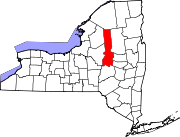Nicholas Herkimer
Nicholas Herkimer | |
|---|---|
 Herkimer at the Battle of Oriskany | |
| Born | c. 1728 German Flatts, New York |
| Died | August 16, 1777 (aged 48–49) German Flatts, New York |
| Allegiance | New York (1758) |
| Service | New York Militia |
| Rank | Brigadier-General |
| Battles / wars | |
Brigadier-General Nicholas Herkimer (also known as Nikolaus Herchheimer; c. 1728 – August 16, 1777) was an American military officer who fought during the French and Indian War and Revolutionary War. He died in 1777 from wounds suffered during the Battle of Oriskany.
Early life and career
[edit]Herkimer was born in the vicinity of German Flatts in the Mohawk Valley of the Province of New York, and was the elder brother of Loyalist officer Johan Jost Herkimer. Their parents were Catherine Petri and Johann Jost Herchheimer, a son of the Palatine immigrant Georg Herchheimer or Hirchemer from Sandhausen in the parish of Leimen south of Heidelberg.[1] Nicholas was of slender build, with a dark complexion and black hair; he was not quite six feet tall. He could speak German, English and Mohawk.
During the attack on German Flatts in the French and Indian War, he was involved in its defense. He was made a captain in the New York Militia on January 5, 1758, and repelled a second attack on German Flatts in April of that year. He built his new house in 1764 on the south shore of the Mohawk River, near the falls and the present-day city of Little Falls; the estate was attended by Irish indentured servants and slaves.[2][3][4] Herkimer joined the Scottish Rite Freemasonry, being initiated in the St. Patrick's Lodge in Johnstown, New York.[5][6]
American Revolution
[edit]In July and August 1775, Herkimer headed the Tryon County Committee of Safety, and became colonel of the Tryon County militia. After the split in which Loyalist militiamen from the area withdrew to Canada, he was commissioned a brigadier-general in the county militia by the Provincial Congress on September 5, 1776. In June 1776, he led 380 men of the Tryon County militia to meet with the Mohawk chief Joseph Brant at Unadilla, New York. Herkimer asked the Mohawk and five other Iroquois nations to remain neutral, while Brant countered that the Indians owed their loyalty to George III.
When Herkimer learned of the British siege of Fort Stanwix to the west in late July 1777, he ordered the Tryon County militia to assemble at Fort Dayton. He marched them out to Fort Stanwix, about 28 miles to the west. His force marching in column was ambushed on August 6 by a mixed force of Loyalist and Hessian regulars and Indian warriors in the Battle of Oriskany. Herkimer's horse was shot, and he was seriously wounded in the leg. In spite of his injuries, he sat propped up against a tree, lit his pipe, and directed his men in the battle, rallying them to avoid two panicked retreats. When they withdrew, they carried him home.
The brigade surgeon, William Petrie, dressed Herkimer's wound in the field and placed him on a litter. The wound quickly became infected, but the decision to amputate the leg was delayed for about ten days after the battle. The operation was performed by an inexperienced surgeon, Robert Johnson, because Petrie had also been wounded in the battle and was not available. The operation went poorly, the wound bled profusely, and Herkimer died of the injury on August 16, at around the age of 49.
Legacy
[edit]
Herkimer's home, in what is now Little Falls, New York, is preserved as the Herkimer Home State Historic Site. Herkimer County, New York was named in his honor.[7] His nephew, John Herkimer, later became a U.S. Congressman. A street in the Bronx, New York City, is named in his honor (Herkimer Place).[8]
In popular culture
[edit]- Roger Imhof portrays Herkimer in the 1939 film Drums Along the Mohawk, directed by John Ford. It is based on the 1936 historical novel by Walter D. Edmonds of the same name, about the Colonial era, settlements in the valley, and the American Revolutionary War.
References
[edit]Notes
- ^ Jones, Henry Z, Jr., The Palatine Families of New York 1710; Universal City, California. 1985, Vol. 1, p. 388-390.
- ^ Falk, Cynthia G. "Forts, Rum, Slaves, and the Herkimer's Rise to Power in the Mohawk Valley," New York History, 89 (Summer 2008), 221–34.
- ^ "Slavery In The Mohawk Valley Event Thursday - New York Almanack". 2017-08-22. Retrieved 2023-08-11.
- ^ Paul A Boehlert (2013). The Battle of Oriskany and General Nicholas Herkimer: Revolution in the Mohawk Valley. Arcadia Publishing. p. 163.
- ^ "U.S. Famous Freemasons". Archived from the original on May 10, 2008.
- ^ "Famous Master Mason". Archived from the original on Jan 4, 2016.
- ^ Gannett, Henry (1905). The Origin of Certain Place Names in the United States. Govt. Print. Off. pp. 155.
- ^ McNamara, John (1991). History in Asphalt. Harrison, NY: : Harbor Hill Books. p. 128. ISBN 0-941980-15-4.
Further reading
- Foote, Allan D., "Liberty March - The Battle of Oriskany," North Country Books Inc., Utica, New York, 1998
External links
[edit]- Herkimer Home State Historical Site
- . Appletons' Cyclopædia of American Biography. 1892.
- Beach, Chandler B., ed. (1914). . . Chicago: F. E. Compton and Co.
- Nicholas Herkimer at Find a Grave
- 1720s births
- 1777 deaths
- American people of German descent
- British America army officers
- German Palatines
- Herkimer County, New York
- Militia generals in the American Revolution
- New York (state) militiamen in the American Revolution
- People from German Flatts, New York
- People of New York in the French and Indian War
- United States military personnel killed in the American Revolutionary War
- Slave owners from the Thirteen Colonies

